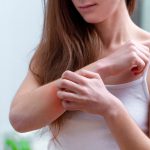Ashwagandha in Sanskrit means “smell of the horse” to correlate it with the strength of…
Read MoreDon’t all of us want healthy glowing skin? And while there is a ton of information out there about taking care of your skin, the basics of skin care actually boil down to a few simple dos and don’ts. Do have a healthy balanced diet that nourishes your skin and protects your skin from the damaging effects of the sun. Don’t use harsh soaps or hot water which can remove skin oils and avoid smoking.[1][Skin care: 5 tips for healthy skin].Mayo Clinic. According to ayurveda, you should customize your skin care regimen according to your prakriti (or constitution which is based on your predominant dosha) so that you can pay attention to your problem areas. If you have
Now that we’ve got the basics down, let’s take a look at some beneficial plants and herbs which can add to your skin care regimen.
Amla is highly valued in ayurveda for its medicinal properties. It is said to have 5 rasas (tastes), amla (sour), kashaya (astringent), tikta (bitter), katu (pungent), and madhur (sweet). Of these the sour and astringent tastes dominate. Amla is also said to alleviate all three doshas – vata, pitta, and kapha.[2]Bhat, Pravin M., Hari Umale, and Madhukar Lahankar. “Amalaki: A review on functional and pharmacological properties.” Journal of Pharmacognosy and Phytochemistry 8, no. 3 (2019): … Continue reading
One study found that having amla fruit extract and lingonberry extract for a period of 12 weeks improved skin elasticity, thickness, hydration, as well as wrinkles in women.[3]Uchiyama, Taro, Makoto Tsunenaga, Miho Miyanaga, Osamu Ueda, and Masashi Ogo. “Oral intake of lingonberry and amla fruit extract improves skin conditions in healthy female subjects: A … Continue reading
Research indicates that amla can inhibit the production of melanin. What is melanin? It is the pigment which gives your skin color. The more melanin you have the darker your skin is. And one study found that the application of a formula containing amla extracts lightened skin in people with hyperpigmented as well as normal skin. This means that amla can be helpful in easing dark spots and sun tans.[4]Chaudhuri, R., Zoia Lascu, and Germain Puccetti. “Inhibitory effects of Phyllanthus emblica tannins on melanin synthesis.” Cosmetics and toiletries 122, no. 2 (2007): 73-81.
Repeated exposure to ultraviolet radiation from the sun can cause premature skin aging as well as skin cancer. But amla can offer some protection against sun damage. Research indicates that it can offer protection against skin inflammation and cell death caused by exposure to ultraviolet radiation. The antioxidant property of amla is thought to be responsible for this effect. You still need to use a good quality sunscreen when you’re out in the sun though![5]Kunchana, Khwandow, Wattanased Jarisarapurin, Linda Chularojmontri, and Suvara K. Wattanapitayakul. “Potential Use of Amla (Phyllanthus emblica L.) Fruit Extract to Protect Skin Keratinocytes … Continue reading
A: Yes, fresh amla paste and amla powder can be applied on your skin. However, it’s typically not applied alone but mixed with ingredients such as yogurt and honey to make a nourishing paste. Do rinse off the face pack once it dries.
A: Amla is a good source of vitamin C which helps in the synthesis of the protein collagen. Collagen can help keep your skin firm and reduce dryness and wrinkles.[7]Borumand, Maryam, and Sara Sibilla. “Daily consumption of the collagen supplement Pure Gold Collagen® reduces visible signs of aging.” Clinical Interventions in Aging 9 (2014): 1747.
A: Amla pacifies all the three doshas: vata, pitta, and kapha. But it is especially calming for pitta dosha. Additionally, it rejuvenates the tissues in the body and builds ojas (the essence of youthfulness and immunity).
A: Sour foods like amla are considered to be incompatible with milk.
Aloe vera has traditionally been used for its medicinal properties not just in India but also in countries like Egypt, Greece, Japan, and Mexico.[8]Surjushe, Amar, Resham Vasani, and D. G. Saple. “Aloe vera: a short review.” Indian journal of dermatology 53, no. 4 (2008): 163. In ayurveda, it’s considered to have the qualities of guru (heaviness), snigdha (oiliness or unctuousness), and picchila (stickiness or sliminess). It is thought to balance all the three doshas- vata, pitta, and kapha. How can it benefit your skin?
According to a study, the application of aloe vera gel (50%) in combination with the topical retinoid known as tretinoin (0.05%) was much more effective at reducing pimples than the using tretinoin alone.[9]Hajheydari, Zohreh, Majid Saeedi, Katayoun Morteza-Semnani, and Aida Soltani. “Effect of Aloe vera topical gel combined with tretinoin in treatment of mild and moderate acne vulgaris: a … Continue reading Research shows that aloe vera can act against bacteria (Propionibacterium acnes) associated with the development of acne.[10]Abiya, S. E., B. O. Odiyi, L. R. Falarunu, and N. U. Abiya. “Antimicrobial activity of three medicinal plants against acne-inducing bacteria Propionibacterium acnes.” Brazilian Journal of … Continue reading
According to research, a compound called aloesin which is present in aloe vera can help reduce melanin. It does this by inhibiting an enzyme known as tyrosinase which plays a role in the production of melanin.[11]Jones, Ken, Jennifer Hughes, Mei Hong, Q. I. Jia, and Steve Orndorff. “Modulation of melanogenesis by aloesin: a competitive inhibitor of tyrosinase.” Pigment cell research 15, no. 5 … Continue reading This means that aloe vera can be helpful in dealing with sun tans, dark spots, and hyperpigmentation.
Aloe vera stimulates cells known as fibroblasts which produce elastin and collagen. Elastic and collagen are proteins which keep the skin elastic, supple, and strong.[12][Skin].Cleveland Clinic. Aloe vera also helps to soften skin and tighten pores. Studies show that it reduces the appearance of fine wrinkles and has an anti-aging effect.[13]Surjushe, Amar, Resham Vasani, and D. G. Saple. “Aloe vera: a short review.” Indian journal of dermatology 53, no. 4 (2008): 163.
According to research, muco-polysaccharides, amino acids, and zinc and amino acids present in aloe vera help in maintaining the moisture and integrity of skin.[14]Zhong, Hongyu, Xiang Li, Wanqi Zhang, Xiaoxiao Shen, Yuangang Lu, and Hongli Li. “Efficacy of a New Non-drug Acne Therapy: Aloe Vera Gel Combined With Ultrasound and Soft Mask for the Treatment … Continue reading Ayurveda credits the snigdha, pichilla, and sheeta (cold) properties of ayurveda for its ability to nourish skin and keep it hydrated.
A: Aloe vera gel can be applied daily to your face; some experts suggest applying it twice a day for best results.
A: Yes, aloe vera can help tackle hyperpigmentation and fade dark spots.
A: Raw aloe vera gel, that is, the transparent gel that you get when you break open and aloe vera leaf can be applied on your face. Test it out on a small patch of skin first to make sure that you do not have an adverse reaction to it and rinse it off after around 10 minutes for best results.
A: Yes, aloe vera has an anti-aging and moisturizing effect on skin. It can also help fade suntans and deal with acne.
A: Yes, aloe vera can help reduce melanin and lighten skin.
A: For best results leave aloe vera gel on your face for about 10 minutes before rinsing it off.
Manjistha has traditionally been used to deal with urinary, blood, and skin diseases since it is reputed to be a blood purifier.[16]Meena, Vandana. “Manjistha (Rubia cordifolia)-A helping herb in cure of acne.” Journal of Ayurveda and Holistic Medicine (JAHM) 3, no. 2 (2015): 11-17.] It is considered to mitigate pitta dosha (pittahara) and thought to be useful in dealing with diseases of tissues where pitta is involved such as your eyes and skin.
According to research, manjistha works against bacteria such as Propionibacterium acne which contribute to the development of acne. It’s anti-inflammatory and antioxidant properties are also beneficial in dealing with acne.[17]Meena, Vandana. “Manjistha (Rubia cordifolia)-A helping herb in cure of acne.” Journal of Ayurveda and Holistic Medicine (JAHM) 3, no. 2 (2015): 11-17.
Manjistha is another herb that can reduce melanin levels. Research indicates that, like aloe vera, it too inhibits the enzyme tyrosinase, which plays a role in the production of melanin. So it can help ease hyperpigmentation, dark spots and suntans.[18]Sharma, Khemchand, Namrata Joshi, and Chinky Goyal. “Critical review of Ayurvedic Varṇya herbs and their tyrosinase inhibition effect.” Ancient Science of life 35, no. 1 (2015): 18. In fact, in ayurveda, manjistha is valued for its ability to improve the complexion (varnakrut).
Like sea buckthorn, manjistha too can be helpful in dealing with eczema. One study observed that the use of an ointment containing manjistha significantly improved symptoms of eczema in participants.[19]Maharashtra-India, Pune. “Treatment of Eczema with an Indigenous Drug Manjishtha (Rubia Cordifolia Linn.)-A Preliminary Study.”
A: Manjistha is considered to be a potent immunity booster that helps the digestive system and alleviates arthritis. The topical application of Manjistha is thought to combat dry skin, rashes, itching and inflammation. It also lightens scars and marks.
A: Manjistha can reduce melanin and lighten skin. It can therefore be helpful in dealing with hyperpigmentation, dark spots, and suntans.
A: Manjistha can be helpful in tackling acne. It acts against bacteria that contribute to the development of acne and also has antioxidant and anti-inflammatory properties that can be helpful in dealing with this condition.
Sea buckthorn has a long history of medicinal use. Herbalists use it to stimulate the digestive system as well as improve liver and heart health. And sea buckthorn oil is particularly popular as a skin care ingredient.
The outermost layer of our skin- which consists of various lipids (fats) and cells called corneocytes which can soak up moisture – works as a barrier.[20][Moisturizers: Do they work?].Harvard Health Publishing. And linoleic acid (omega-6 fatty acid) which is present in sea buckthorn oil strengthens the lipid barrier of skin and protects against water loss. Other omega fatty acids such as omega-3 (alpha-linolenic acids), and omega-9 (oleic acid) also help reduce water loss from skin and improve skin hydration.[21]Zielińska, Aleksandra, and Izabela Nowak. “Abundance of active ingredients in sea-buckthorn oil.” Lipids in health and disease 16, no. 1 (2017): 1-11.
Sea buckthorn oil is known for its anti-aging effects as it has antioxidant properties. Moreover, due to the presence of unsaturated fatty acids such as palmitoleic acid and gamma-linolenic acid in sea-buckthorn oil it can help regenerate and repair skin.[22]Zielińska, Aleksandra, and Izabela Nowak. “Abundance of active ingredients in sea-buckthorn oil.” Lipids in health and disease 16, no. 1 (2017): 1-11. One study found that both consuming and applying sea buckthorn oil had anti-aging effects as it significantly improved skin elasticity and hydration.[23]Yang, Baoru, Adriana Bonfigli, Valerie Pagani, Tiina Isohanni, Asa von-Knorring, Arimatti Jutila, and Vesa-Pekka Judin. “Effects of oral supplementation and topical application of supercritical … Continue reading
Eczema or atopic dermatitis, is an inflammatory skin condition characterized by itchy, dry skin that oozes a clear fluid when you scratch it.[24][Eczema (Atopic Dermatitis)](Eczema (Atopic Dermatitis) | NIH: National Institute of Allergy and Infectious Diseases “Eczema (Atopic Dermatitis)).National Institutes of Health. One study found that supplementation with sea buckthorn pulp oil significantly improved the condition. The fatty acids present in the oil are thought to be responsible for this effect.[25]Yang, Baoru, Kirsti O. Kalimo, Leena M. Mattila, Sinikka E. Kallio, Jouko K. Katajisto, Olli J. Peltola, and Heikki P. Kallio. “Effects of dietary supplementation with sea buckthorn (Hippophae … Continue reading
Overexposure to the sun can result in skin damage due to free radicals. But antioxidants can neutralize free radicals and help prevent damage. Research shows that sea buckthorn oil can stimulate the antioxidant system in skin cells and therefore might have a protective effect against sun damage. Do keep in mind that it’s a good idea to use a high quality sunscreen when you’re out in the sun.[26][Aging & Painful Skin]. Cleveland Clinic. [27]Gęgotek, Agnieszka, Anna Jastrząb, Iwona Jarocka-Karpowicz, Marta Muszyńska, and Elżbieta Skrzydlewska. “The effect of sea buckthorn (Hippophae rhamnoides L.) seed oil on UV-induced changes … Continue reading
One study found that a cream containing sea buckthorn fruit extract was able to reduce the melanin content of skin. Therefore, it can be beneficial in easing dark spots, hyperpigmentation, and suntans.[28]Khan, Barkat Ali, Naveed Akhtar, Tariq Mahmood, Haji M. Shoaib, Mughal Qayum, and Tariq Saeed. “Effects of antioxidants and flavonoids of sea buckthorn on skin whitening and skin … Continue reading
A: Sea buckthorn fruit extracts can reduce the melanin content of your skin and help brighten it.
A: Sea buckthorn oil has been found to have anti-aging effects. It can improve skin elasticity and hydration which can help with wrinkles.
A: Sea buckthorn can help reduce melanin so it might help fade dark spots and scars. However, it might not be useful for pitted or raised scars.
Native to South America and the Caribbean, acerola or Barbados cherries are a sweet to tart in flavor. They’re considered to be beneficial for the health of your liver and they help with weight management. As far as your skin goes acerola cherries:
One animal study found that supplementation with acerola berry was effective at suppressing darkening of skin due to exposure to ultraviolet radiation. It is thought to do this by inhibiting genes involved in the production of melanin.[30]Sato, Yasunori, Eriko Uchida, Hitoshi Aoki, Takayuki Hanamura, Kenichi Nagamine, Hisanori Kato, Takeshi Koizumi, and Akihito Ishigami. “Acerola (Malpighia emarginata DC.) juice intake … Continue reading
Acerola cherries are very rich in vitamin C. And vitamin C helps provide protection against the damaging effects of sun exposure as it has antioxidant properties. It also stimulates the synthesis of collagen so it might help keep your skin looking young.[31]Pullar, Juliet M., Anitra C. Carr, and Margreet Vissers. “The roles of vitamin C in skin health.” Nutrients 9, no. 8 (2017): 866. And do keep in mind that a healthy balanced diet plays an important role in keeping your skin healthy.
A: Acerola cherries are a great source of vitamin C. They may also support the health of your liver and help with weight management.
A: Research indicates that vitamin C is better absorbed from acerola cherries than synthetic ascorbic acid.[34]Prakash, Anand, and Revathy Baskaran. “Acerola, an untapped functional superfruit: a review on latest frontiers.” Journal of food science and technology 55, no. 9 (2018): 3373-3384.
References
| ↑1 | [Skin care: 5 tips for healthy skin].Mayo Clinic. |
|---|---|
| ↑2 | Bhat, Pravin M., Hari Umale, and Madhukar Lahankar. “Amalaki: A review on functional and pharmacological properties.” Journal of Pharmacognosy and Phytochemistry 8, no. 3 (2019): 4378-4382. |
| ↑3 | Uchiyama, Taro, Makoto Tsunenaga, Miho Miyanaga, Osamu Ueda, and Masashi Ogo. “Oral intake of lingonberry and amla fruit extract improves skin conditions in healthy female subjects: A randomized, double‐blind, placebo‐controlled clinical trial.” Biotechnology and applied biochemistry 66, no. 5 (2019): 870-879. |
| ↑4 | Chaudhuri, R., Zoia Lascu, and Germain Puccetti. “Inhibitory effects of Phyllanthus emblica tannins on melanin synthesis.” Cosmetics and toiletries 122, no. 2 (2007): 73-81. |
| ↑5 | Kunchana, Khwandow, Wattanased Jarisarapurin, Linda Chularojmontri, and Suvara K. Wattanapitayakul. “Potential Use of Amla (Phyllanthus emblica L.) Fruit Extract to Protect Skin Keratinocytes from Inflammation and Apoptosis after UVB Irradiation.” Antioxidants 10, no. 5 (2021): 703. |
| ↑6 | Rao, Theertham Pradyumna, Takayuki Okamoto, Nobuyuki Akita, Tatsuya Hayashi, Naomi Kato-Yasuda, and Koji Suzuki. “Amla (Emblica officinalis Gaertn.) extract inhibits lipopolysaccharide-induced procoagulant and pro-inflammatory factors in cultured vascular endothelial cells.” British journal of nutrition 110, no. 12 (2013): 2201-2206. |
| ↑7 | Borumand, Maryam, and Sara Sibilla. “Daily consumption of the collagen supplement Pure Gold Collagen® reduces visible signs of aging.” Clinical Interventions in Aging 9 (2014): 1747. |
| ↑8, ↑13 | Surjushe, Amar, Resham Vasani, and D. G. Saple. “Aloe vera: a short review.” Indian journal of dermatology 53, no. 4 (2008): 163. |
| ↑9 | Hajheydari, Zohreh, Majid Saeedi, Katayoun Morteza-Semnani, and Aida Soltani. “Effect of Aloe vera topical gel combined with tretinoin in treatment of mild and moderate acne vulgaris: a randomized, double-blind, prospective trial.” Journal of Dermatological Treatment 25, no. 2 (2014): 123-129. |
| ↑10 | Abiya, S. E., B. O. Odiyi, L. R. Falarunu, and N. U. Abiya. “Antimicrobial activity of three medicinal plants against acne-inducing bacteria Propionibacterium acnes.” Brazilian Journal of Biological Sciences 5, no. 10 (2018): 277-288. |
| ↑11 | Jones, Ken, Jennifer Hughes, Mei Hong, Q. I. Jia, and Steve Orndorff. “Modulation of melanogenesis by aloesin: a competitive inhibitor of tyrosinase.” Pigment cell research 15, no. 5 (2002): 335-340. |
| ↑12 | [Skin].Cleveland Clinic. |
| ↑14 | Zhong, Hongyu, Xiang Li, Wanqi Zhang, Xiaoxiao Shen, Yuangang Lu, and Hongli Li. “Efficacy of a New Non-drug Acne Therapy: Aloe Vera Gel Combined With Ultrasound and Soft Mask for the Treatment of Mild to Severe Facial Acne.” Frontiers in Medicine 8 (2021): 732. |
| ↑15 | Surjushe, Amar, Resham Vasani, and D. G. Saple. “Aloe vera: a short review.” Indian journal of dermatology 53, no. 4 (2008): 163. |
| ↑16, ↑17 | Meena, Vandana. “Manjistha (Rubia cordifolia)-A helping herb in cure of acne.” Journal of Ayurveda and Holistic Medicine (JAHM) 3, no. 2 (2015): 11-17. |
| ↑18 | Sharma, Khemchand, Namrata Joshi, and Chinky Goyal. “Critical review of Ayurvedic Varṇya herbs and their tyrosinase inhibition effect.” Ancient Science of life 35, no. 1 (2015): 18. |
| ↑19 | Maharashtra-India, Pune. “Treatment of Eczema with an Indigenous Drug Manjishtha (Rubia Cordifolia Linn.)-A Preliminary Study.” |
| ↑20 | [Moisturizers: Do they work?].Harvard Health Publishing. |
| ↑21, ↑22 | Zielińska, Aleksandra, and Izabela Nowak. “Abundance of active ingredients in sea-buckthorn oil.” Lipids in health and disease 16, no. 1 (2017): 1-11. |
| ↑23 | Yang, Baoru, Adriana Bonfigli, Valerie Pagani, Tiina Isohanni, Asa von-Knorring, Arimatti Jutila, and Vesa-Pekka Judin. “Effects of oral supplementation and topical application of supercritical CO2 extracted sea buckthorn oil on skin ageing of female subjects.” Journal of Applied Cosmetology 27, no. 1 (2009): 13. |
| ↑24 | [Eczema (Atopic Dermatitis)](Eczema (Atopic Dermatitis) | NIH: National Institute of Allergy and Infectious Diseases “Eczema (Atopic Dermatitis)).National Institutes of Health. |
| ↑25 | Yang, Baoru, Kirsti O. Kalimo, Leena M. Mattila, Sinikka E. Kallio, Jouko K. Katajisto, Olli J. Peltola, and Heikki P. Kallio. “Effects of dietary supplementation with sea buckthorn (Hippophae rhamnoides) seed and pulp oils on atopic dermatitis.” The Journal of nutritional biochemistry 10, no. 11 (1999): 622-630. |
| ↑26 | [Aging & Painful Skin]. Cleveland Clinic. |
| ↑27 | Gęgotek, Agnieszka, Anna Jastrząb, Iwona Jarocka-Karpowicz, Marta Muszyńska, and Elżbieta Skrzydlewska. “The effect of sea buckthorn (Hippophae rhamnoides L.) seed oil on UV-induced changes in lipid metabolism of human skin cells.” Antioxidants 7, no. 9 (2018): 110. |
| ↑28 | Khan, Barkat Ali, Naveed Akhtar, Tariq Mahmood, Haji M. Shoaib, Mughal Qayum, and Tariq Saeed. “Effects of antioxidants and flavonoids of sea buckthorn on skin whitening and skin erythema.” Asian Journal of Chemistry 23, no. 2 (2011): 903. |
| ↑29 | [What Is Sea Buckthorn?](.Verywell Health. |
| ↑30 | Sato, Yasunori, Eriko Uchida, Hitoshi Aoki, Takayuki Hanamura, Kenichi Nagamine, Hisanori Kato, Takeshi Koizumi, and Akihito Ishigami. “Acerola (Malpighia emarginata DC.) juice intake suppresses UVB-induced skin pigmentation in SMP30/GNL knockout hairless mice.” Plos one 12, no. 1 (2017): e0170438. |
| ↑31 | Pullar, Juliet M., Anitra C. Carr, and Margreet Vissers. “The roles of vitamin C in skin health.” Nutrients 9, no. 8 (2017): 866. |
| ↑32 | [Vitamin C]. National Institutes of Health. |
| ↑33 | [Barbados Cherry Nutrition Facts and Health Benefits].Verywell Fit. |
| ↑34 | Prakash, Anand, and Revathy Baskaran. “Acerola, an untapped functional superfruit: a review on latest frontiers.” Journal of food science and technology 55, no. 9 (2018): 3373-3384. |


Dr. Manjula has 12 years of experience in the field of Ayurveda and worked as a Consultant and General Physician for over 5 years before starting her private practice. In addition to BAMS, she also has an Advanced Diploma in Clinical Research and is trained in Panchkarma. She is an expert at diagnosis of the root cause and planning effective treatment for multiple issues.

Ashwagandha in Sanskrit means “smell of the horse” to correlate it with the strength of…
Read More
Pimples - we’ve all had them and we all hate them. And if you’ve ever…
Read More
Most of us have experienced skin irritations at some point or the other. When the…
Read More
Healthy, radiant, youthful skin is something that we all desire. However, we might unwittingly have…
Read More